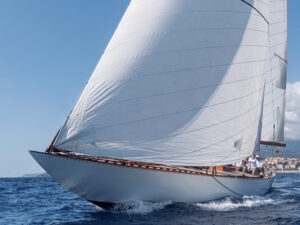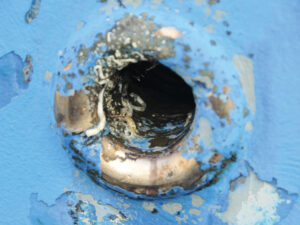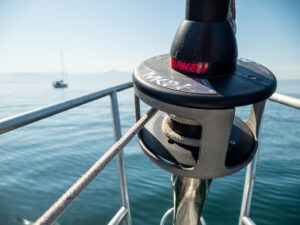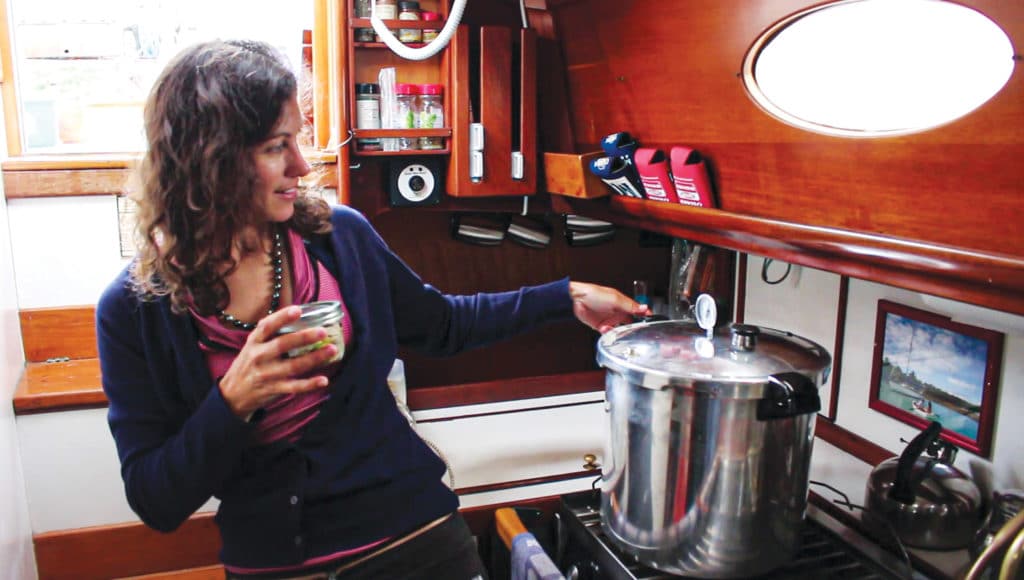
The great variation from summer to winter in Alaska means that the residents of the Last Frontier are adept at catching and preserving wild food. Whether it’s with caribou or blueberries, Alaskans make sure their larders are stocked before the darkness and snow descend.
As transient sailors in Alaska for a number of years, my husband, Seth, and I got caught up in the notion of gathering wild food and preserving it for future eating. Long-distance sailing tends to draw people who welcome a life of self-reliance, and providing for yourself from land and sea is an obvious extension of that (see “Sailing for Fishing,” January 2020). In particular, we got excited about catching and preserving salmon. As nonresidents, we were limited to rod-and-reel fishing, and so our harvest wasn’t a patch on the year-rounders’ net-fishing, but we still pulled in much more than we could eat. We don’t have a freezer, and the catch would have taken up more room than a typical boat freezer offers anyway, so we canned it.
Canning fish or meat requires a pressure canner. Water-bath canning is acceptable for jams and pickles and the like, but the low temperature isn’t safe for low-acid foods such as fish and meat. Seth and I have a Presto 16-quart stainless-steel pressure canner, which holds 12 half-pint jars and can reach a pressure of 15 psi. Before setting up the canner, however, we liked to hot-smoke our fish.
When you buy smoked salmon, you are buying cold-smoked fish; it’s been brined, refrigerated, and then smoked for between 12 and 24 hours. We don’t have a smoker capable of that, so when we were in Alaska, our method was to hot-smoke fish in our grill, using green alder branches to provide the smoke.
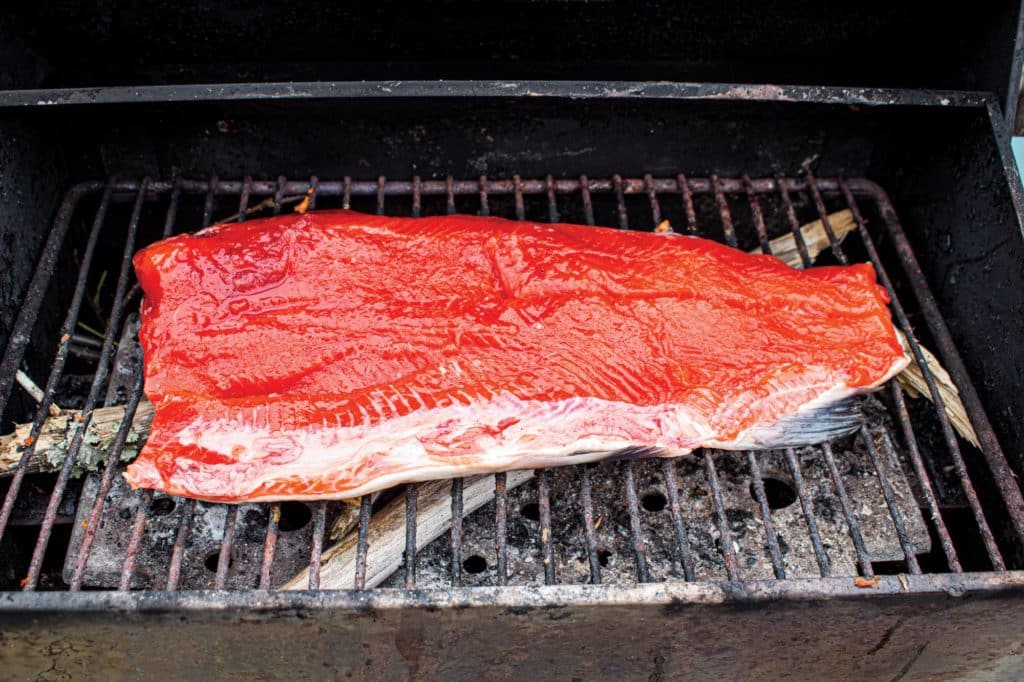
In the meantime, while the fish was cooking, we washed all our Mason jars and got out new lids and rings. It’s a good idea to keep the jars hot (leave them in very hot water) so that they don’t crack. We then filled each jar with the fish, a little lime or lemon peel, and vegetable oil, getting rid of any air bubbles with a clean plastic spatula (metal utensils can damage the jar). It’s imperative to always leave about an inch of airspace below the lid and to wipe the rim of the jar very clean. Otherwise you risk not having a good seal, which can lead to spoiling and even botulism, which is odorless and very dangerous, and sometimes fatal.
Once the rims were perfectly clean, we put on the lids and rings, making sure not to tighten the rings all the way. This way air can escape during the canning and cooling. Once all the air is eventually released by the end of the process, a vacuum has been created and the lid will seal. It makes a characteristic popping noise once it does.
Read More: Hands-On Sailor
But we were still back at the stage of putting on the lids and rings. Once that was complete, the rack that came with the canner went into it in order to hold the jars off the bottom. I poured warm water into the canner to the amount specified (there’s a line on the inside of the canner), and then placed the jars in, careful to leave enough space between them. Then I secured the lid of the canner (which has a gasket), but I left off the pressure-regulator weight on the air vent. That way the canner could vent off all the air and create a purely steam environment for the canning.
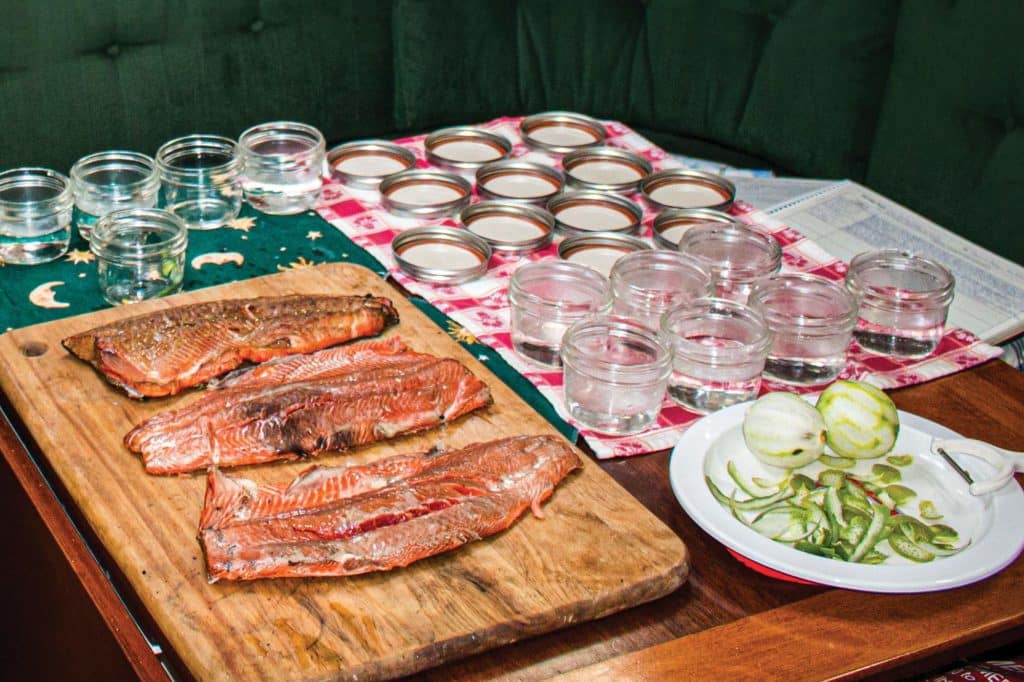
After the water in the canner boiled, the venting took about 10 minutes before I could put on the weight and watch the pressure in the canner mount to the appropriate pounds per square inch—in this case, 11 psi. (There is a dial on the lid that measures pressure.)
The canner required fairly constant monitoring to make sure the pressure stayed at the right level; I frequently adjusted the gas on the stove to keep the right heat, even while using a “flame-tamer” heat distributor. For our salmon and canner, we maintained the 11 psi pressure for 100 minutes before turning off the stove and letting the canner and jars cool.
Once all the pressure in the canner was gone, we could open the lid and remove the jars with the tongs that came with the canner (the jars are still very hot!). I placed them on a thick dish towel and left them there to cool. When the lids had sealed and we’d tightened the rings, the jars were set to store. We always make sure to write the date on the lids with a Sharpie first though. It’s usually not that long before we’ve opened a jar for a delicious hors d’oeuvre, but it’s good practice.
I find canning in the galley to be fairly easy and straightforward, and not too much different from canning in a house kitchen. The three big differences are space, of course, the lack of a dishwasher, and the size of the canner.
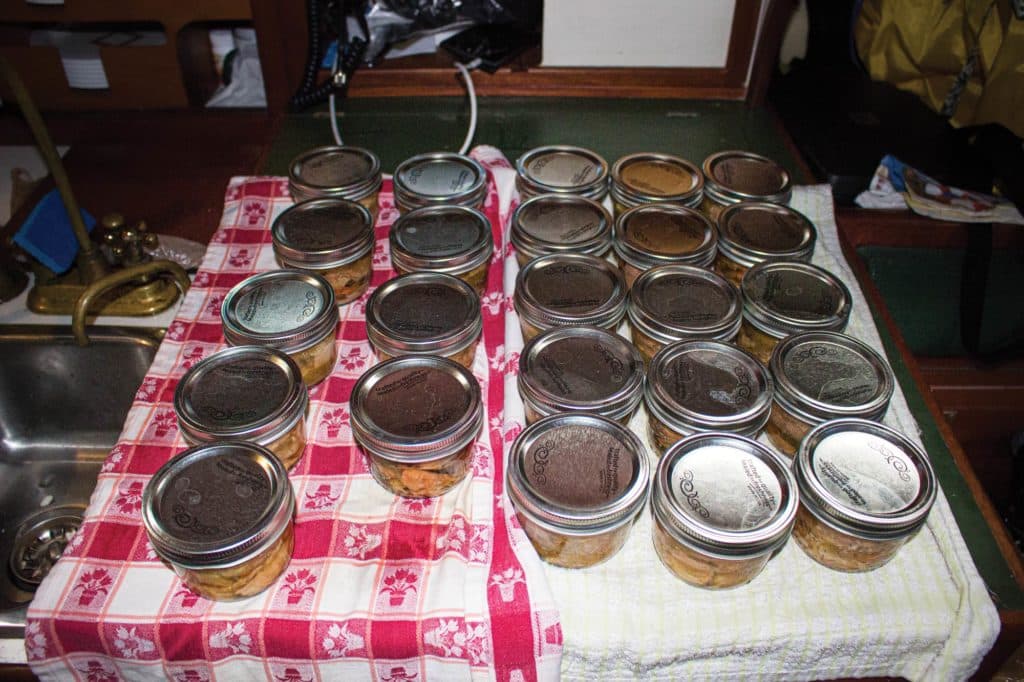
Canning takes up most of the saloon space, between washing the jars and laying them out to be filled with fish, and then laying them out to cool at the end. So, it becomes an activity that everyone on board is necessarily involved in (there’s no room to do much else!), whereas at home I can do the canning in the kitchen, and life in the rest of the house goes on as usual.
Washing the jars is a bit more of a project on the boat than it would be at home, where I could simply put the jars in the dishwasher and take them out one by one to fill and place in the canner, thereby keeping them very hot from the dishwasher steam while they await filling.
And finally, the canner is smaller than the one I have at home and therefore requires about two batches for every one I make at home. But our boat canner fits perfectly on our galley stove, and it stores well in a deep locker, while a bigger one would not fit. Otherwise, the process is pretty well the same, and the resulting food is just as good!
Salmon To Go
Here are three ways we put our canned salmon to good use when we’re sailing:
• Hors d’oeuvres. It’s a classy and delicious topping to a cracker and cream cheese.
• Maki sushi rolls. Rolled up in nori (roasted seaweed) and sushi rice, it’s great on its own or combined with avocado, cucumber and/or cream cheese.
• Fettucine Alfredo. It makes your favorite homemade creamy pasta sauce a whole lot more interesting, and it’s fast and easy to add. This one is a stand-by for me on passages.
Writer and photographer Ellen Massey Leonard is a frequent CW contributor.

